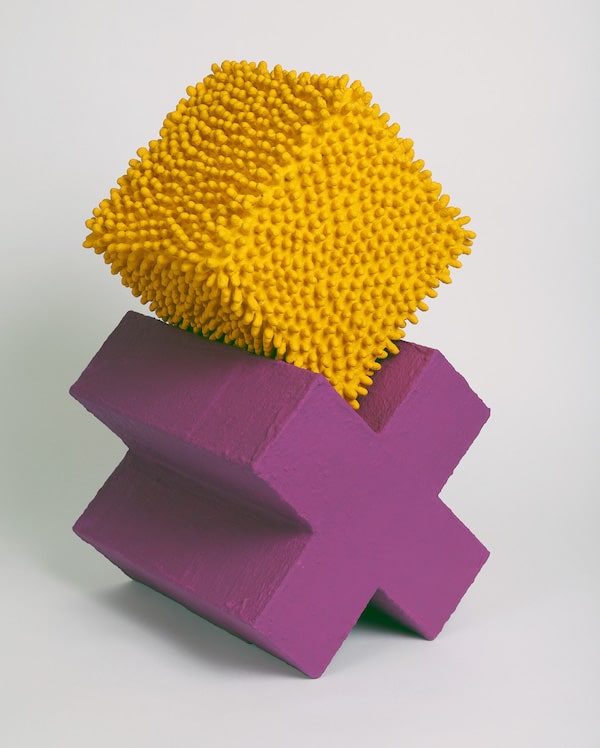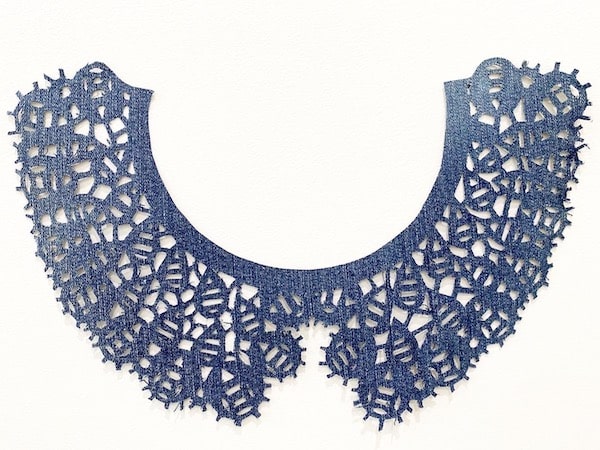As a professionally exhibiting artist for over 20 years, I’ve met people whose understandings of how art appreciation fits into their lives, what it means to be a working artist, and what constitutes “good” art vary wildly. Although humans have been making, using, and experiencing art for at least 40,000 years, art somehow became separated from daily life for most of us and shrouded in mystery and magic. But as the Pulitzer Prize-winning art critic
Jerry Saltz says, “Art is for anyone.” (For the sake of completeness, the rest of the quote is “Art is not for everyone.” And it isn’t. But if it’s not for you, it shouldn’t be because you’re intimidated by “experts.”)
I hope that by making the possibility of living with contemporary art more accessible and down to earth, more of us can experience the richness it can bring to our lives. I’ll start by sharing some of my story and answering some questions I’m often asked. I’ve found that people who haven’t done art since they were schoolkids but are considering picking up a brush or lump of clay will ask questions about how I got started, where I went to school, and how I came to do what I do. If you’re like them and want to experience the pleasure of making again, are curious about why artists do what they do, or are simply interested in the creative life, read on!
The Makings of an Artist
Many artists have similar stories to answer the question, “How did you become an artist?”: art isn’t so much a life you choose as one that chooses you. I knew that I wanted to be an artist in kindergarten. One of the first and most valuable lessons of my early education was that making something as others look on, without quite knowing what will happen, is a remarkable shared experience. Lots of kids have a facility for drawing but discovering that facility is, for some people, like finding a treasure map that you’ll follow all your life.
I didn’t realize the implications of following that map until much later. Studying art, art history, and, later, graphic design transformed my way of thinking about my life’s purpose and how I could use my knowledge and skills in service of others.
Understanding Art Appreciation
Another question I often get is, “What is your art about?” Ultimately, I think all art is about what it means to be human. What are we doing here? Who am I? What is my place in the world? It’s a way to convey thoughts and feelings that can’t be put into words. For me, it’s a way to process complex experiences and try to make sense of them.
People like to talk about “self-expression” but that doesn’t interest me particularly. I have a private, personal experience, and while that certainly finds its way into the work and is important, I’m asking viewers to have their own experiences and to find their own meaning. An artist chooses materials, forms, colors, and so on with some intent in mind, creates a thing (or a situation), then makes it available to others. That’s the end of the artist’s obligation; the viewer can choose to meet the artist halfway or not.
Some artists are interested in telling a story — depicting a landscape, people, a historical event, and so on. Those depictions may be straightforward or not so straightforward, but usually viewers can recognize objects and comfortably form some sort of idea about what’s going on. My problem with that — and I suspect others’ too — is that it’s too easy for someone to assess what they think is happening quickly, assume they know everything there is to know about the work and move on. A sculpture or painting is often judged on how closely it resembles a real thing or a photograph of a real thing, so it’s always pointing to something else or somewhere else and isn’t an independent thing — an object — in itself. But I want to offer viewers a different kind of relationship with the art: to see the art as almost a living thing —a kind of companion.

Kim Matthews, “Joy Diffuser” (2021). Concrete and acrylic media on styrofoam, Q-Tips, and bamboo. I’m interested in art as a tool to bring healing, happiness, joy, or delight. People are often surprised when they find out what kinds of things I use to make my sculpture, which is part of the fun!
As for me, I’m interested in domestic objects — the things in our homes that help us perform basic functions like eating or sitting — and the possibility of making art integrated with daily living. And while these kinds of objects are typically referred to as “design” or “craft” because the degree to which they are practical and useful they are is the priority and determines their value and success as objects, I believe that helping people feel peaceful or happy is ultimately very practical too. I think we need homes that are soothing and provide respite. And I think that we need to engage all our senses in order to feel grounded and whole.
While what I make isn’t topical or narrative, it’s not devoid of content — that is, it’s not “about” nothing. For the past two or so years, I’ve been making two distinct bodies of work: a series of 108 slowly evolving, contemplative geometric drawings based on my meditation practice and fluorescent mixed-media sculptures inspired by the art, design, and pop culture of my childhood. Although very different, they’re similar in that they reflect an interest in process and material exploration. How something is made and what it’s made of affect how it acts on you.
Those choices say something, and artists think about things like that. The materials I choose and how I engage with them are important to me. My working process is a spiritual activity connected to my daily meditation practice. I hope my objects evoke feelings of peace, joy, or delight. You can see them and read more here on
Artrepreneur.
Fostering Art Appreciation in Your Life
Why art? Why not? You don’t have to be a trained professional to have meaningful, even life-changing experiences with art. Making art can relieve stress—world leaders from Winston Churchill to George H.W. Bush have painted for leisure and found great fulfillment. Churchill even wrote a book about it, “Painting as a Pastime,” in which he stated, “Painting is complete as a distraction. I know of nothing which, without exhausting the body, more entirely absorbs the mind.”
But if you’re not quite ready to don a smock and a beret, there are many other ways to foster art appreciation in your life. Going to museums is a great way to begin. Many museums have docents: volunteers who lead tours and are available to answer questions if you’re not the type to take recorded tours or read wall labels. If you live in a small town or city, a nearby museum may focus on artists from your town, state, or region, so there will be plenty of interesting things to learn and appreciate about local history. And if you live near a big city, there may be large museums with holdings from around the world, from ancient history to contemporary; you’re sure to find something intriguing there.
Then there are galleries of all sizes — from coffee shops to pop-ups to blue chips. A good gallerist is also an enthusiastic art lover who loves sharing their knowledge and enthusiasm about the artists they’re exhibiting. If you happen to encounter a gallery worker who seems a little aloof or is busily trying to close a sale when you want to introduce yourself or ask a question about an artwork, don’t worry. Gallery staff knows that strong relationships with curious members of the public, as well as buyers, are vital to their success, and those relationships take time and attention. You belong there, just like everyone else.

Artist Libby Newell’s choice of materials (repurposed blue jeans) transforms them into a “lace” collar while telling a story about sustainability.
10 Ways Art Appreciation Changed My Life—and How It Can Change Yours
If you’re still wondering whether investing your valuable time and/or money in participating in art is worthwhile, here are some personal examples of how art can enrich your life, in no particular order.
- Making art gives me a sense of balance, accomplishment, and purpose.
- Artmaking helps me understand myself and my place in the world.
- Looking at others’ art, whether historical or contemporary, reminds me that I’m part of a vast community that extends all around the world, throughout human history.
- Sharing my work with those who enjoy — or at least appreciate — it is an incredible gift, an honor, and a pleasure.
- I’ve made treasured, enduring friendships by attending workshops and exhibitions.
- Studying art history has helped me understand human history through the lens of politics, culture, and technology and how our seemingly insurmountable, unique problems aren’t unique after all.
- Making art is essentially creating problems in order to solve them. How do I fit these things together? How can these incompatible materials work together? How can I build this object so it doesn’t fall over? What happens when…? Learning how to solve problems is valuable in daily life and work and helps people be more resilient in the face of struggle—something we all need and will continue to need.
- Being committed to my practice means I’m studying, learning, and growing all the time. When I have a creative block, I don’t try to plow through it. Instead, I clean the studio, read, look at other artists’ work or just poke around online to find what piques my interest and see if there’s some idea worth pursuing. And there’s always something to improve or learn about, whether that’s business practices or technical skills.
- Making art reduces my resistance to change. I’m not one of those people who grits their teeth and exclaims, “I love change!” Because I don’t. Really. But I know that change and growth vital for our survival and that those who try to resist the ever-quickening change we’re currently experiencing will suffer greatly.
- Art, and art appreciation, grounds me in here-and-now reality because, whether making it or looking at it, being fully present is required. What you get out of it is proportionate to what you put in.

Alfonso Sánchez Pérez, “Crazy Indeed” (2022). The Spanish painter uses tools from spatulas to spray bottles to create vivid, improvisational compositions informed by urban life, music, graphic design and art history. The evidence of the process of the making of the work brings it to life.
While marketers have seized on our need for “authentic,” tactile experiences, there’s a real qualitative difference between a mass-produced consumer item and one that’s crafted with intent and care. Maybe that’s not obvious at first, but that’s part of what experts are getting at when they talk about connoisseurship. And connoisseurship can be learned and is worth learning. It’s not about how much money you have.
Anyone with enough resources can collect the hot new artist or most coveted luxury goods, but price and value are two different things. Just watch a child collecting beach glass or stones. They’re curious. They’re looking closely. They’re discovering what they like and don’t like, and it has nothing to do with money.
____________________
The good news is we can reclaim our childlike curiosity while deepening our understanding of our preferences and others’. You can start right now. Do you prefer bright colors and bold shapes or soft colors and shapes? Do you like more lifelike art or more expressive art? Some people have favorite museum artworks that they always visit — how about you? What makes them your favorites? Let us know in the comments!
